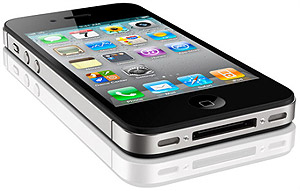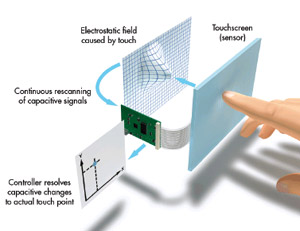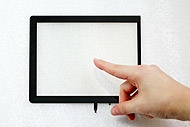Capacitive touch screens have revolutionized how we interact with technology in our daily lives. From computers and tablets to smartphones, these screens have become ubiquitous. With just a few simple gestures on the screen, you can effortlessly access information or complete transactions. This ease of use, enabled by the advancement of capacitive touch screen technology, has made these screens an integral part of our everyday experience. But when did capacitive touch screens start playing such a pivotal role in our lives? Let's delve into what capacitive touch screens are and the advantages they offer.
Understanding How Capacitive Touch Screens Work.
Capacitive touch screens operate on the principle of 'capacitance,' the ability to store an electrical charge. This fundamental concept is what makes capacitive touch screens highly effective. When a person uses a capacitive touch screen, their touch forms a circuit with the screen, altering its capacitance at the contact point. This is because the finger, by approaching or touching the capacitive touch screen, attracts more charge, increasing the screen's capacitance. The controller within these capacitive touch screens then detects this change and accurately calculates the touch's location. Modern capacitive touch screens are advanced enough to detect multiple touch points simultaneously, a feature known as multi-touch. This capability is achieved by analyzing the changes in capacitance at various points on the screen. Compared to traditional resistive touch screen, capacitive touch screens offer superior scratch resistance, better smudge resistance, and a faster, more responsive user interaction.


Exploring the Types of Capacitive Touch Screens
Capacitive touch screens, a pivotal technology in modern interactive devices, come in two primary types: Surface Capacitive and Projected Capacitive. Each type has distinct applications and products, stemming from their unique technical principles.
Surface Capacitive Touch Screens
In a Surface Capacitive touch screen, the surface is coated with a transparent conductive layer, typically made of tin oxide (ITO). The human body's conductive nature plays a key role here. When a finger touches the screen, it alters the static electric field at that point of contact. This change in the electric field is used to detect the exact location of the touch, making surface capacitive screens a reliable choice for various applications.
Projected Capacitive Touch Screens
Projected Capacitive touch screens are designed with two layers of conductive material, arranged in a grid pattern of rows and columns. This structure forms a sophisticated capacitive grid. Touching the screen with a finger changes the capacitance at specific grid intersections, allowing for precise detection of the touch position. This technology is particularly renowned for its ability to accurately track multiple touch points simultaneously, enhancing user interaction.
Capacitive touch screens have transformed how we interact with technology, offering intuitive and responsive experiences across various devices. Understanding the differences between Surface and Projected Capacitive touch screens helps in selecting the right technology for specific applications.
Specification of Touch Screen
|
Surface Capacitance |
Projected Capacitance |
| Technical Principle |
Single-layer IndiumTin Oxide (ITO) |
Projected Capacitance Touch; PCT |
| Touch Capability |
Single touch detection only |
Can detect and process multiple touch points simultaneously. |
| Sensitivity and accuracy |
Lower |
Higher |
| Durability |
Simple structure, more durable |
Complex construction, may be more sensitive to the environment |
| Applications |
Public information kiosks: e.g. shopping centers, airports, museums.
Self-service information kiosks: e.g. ATMs, self-service ticket machines, self-service checkout machines. Industrial control panels
|
Smart phones, tablet PCs, touch screen laptops |
Advantages of Capacitive Touch Screen
The most significant advantage of projected capacitive touch technology lies in its precision, which facilitates an exceptionally smooth operating experience. This is particularly beneficial for rapid interactions on smartphones. The superior smoothness of these screens offers several key advantages:
Ease of use
Intuitive hand movements are all it takes to accomplish tasks, bypassing the need for complex procedures. This user-friendly design streamlines interactions, making it simpler and more efficient to navigate.
Rapid Response Time
In today's fast-paced world, the ability to operate quickly is invaluable. Capacitive touch screens respond instantly to touch, significantly reducing the time spent on each interaction and enhancing overall productivity
High Accuracy
Projected capacitive touch panels are not just responsive; they are also remarkably precise. This high level of accuracy ensures a more satisfying user experience and enables precise operations, which is essential for tasks requiring fine control.
Understanding the Limitations of Capacitive Touch Screens
While capacitive touch screens offer numerous advantages, they also come with certain limitations that are important to consider.
Susceptibility to Interference
One of the challenges with capacitive touch screens is their potential susceptibility to signal interference. This issue largely depends on the panel's design. Typically, in-cell sensors in these screens are more prone to interference compared to on-cell sensors, which can affect the screen's performance and accuracy.
Higher Production Costs
Another significant consideration is the cost. The production of projected capacitive touch screens, particularly the ITO (Indium Tin Oxide) layer, is notably more expensive than that of resistive touch screens. This is due to the complex structure and the materials required for manufacturing, contributing to a higher overall cost.
Dependence on Direct Finger Touch
Capacitive touch screens rely on the electrical conductivity of the human body. As a result, they may not function optimally when touched through gloves, and their performance can be hindered by the presence of water droplets on the screen.
Choose Elcom for Capacitive Touch Screens that epitomize reliability and quality. We promise our clients top-tier products with consistent delivery. Trust in Elcom for your touch screen needs and experience excellence in every order. Don't hesitate to contact us for your next project — we're here to provide the best touch screen solutions tailored to your needs.
| Electrical |
Maximum Circuit Rating |
5V DC, 35mA |
|---|
| Insulation Resistance |
Maxtrix 20MΩ or more at 50V DC |
| |
Analog 20MΩ or more at 25V DC |
| Dielectric Withstand |
250V Rms (50-60Hz 1min) |
| Contact Bounce |
30ms or less |
| Mechanical |
Actuation Force |
10g to 100g |
|---|
| Linearity |
1.5% or less |
| Life Expectancy |
35,000,000 touches |
| Surface Hardness |
3H or more |
| Glass Thickness |
0.7mm, 1.1mm, 2.0mm, 3.0mm |
| Environmental |
Operation Temperature |
-10°C to + 60 °C |
|---|
| Storage Temperature |
-20°C to + 70 °C |
| Humidity |
40°C , 90% to 95% for 240 hours |
| Optical |
Transparency |
≥80% ± 2% |
|---|
| Structure |
Film to Glass |



